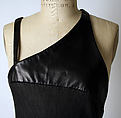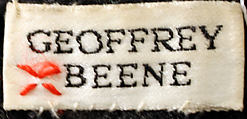Dress
Designer Geoffrey Beene American
Not on view
The recent work of Geoffrey Beene has been characterized by an increasingly sensual reductivism. In this evening gown an asymmetrical yoke in black leather acknowledges the anatomy-the clavicle, sternum, and spine-while also evoking another reference, that of a shoulder holster, in its trapezoidal shape, strapping, and use of material. As in many of Beene's designs, the yoke is a detail simultaneously abstract and allusive, a vestige of earlier collections in which harnesses appeared as separate accessories to overlay, segment, and define the torso.
A subtle provocative intent has always percolated through the designer's collections. Here Beene refutes precedent and resists convention when he employs gray wool jersey and black leather, materials generally consigned to day- or sportswear. Cut in one piece, with only a center-back seam, the body of the gown reveals Beene's essentially Minimalist strategy. Still, like an architectural detail by Santiago Calatrava, whose work is characterized by zoomorphic bone- and riblike vaults, Beene's supporting yoke introduces a decorative flourish through its arcing organicism. The American designer reveals, as does the Spanish architect in his elegant engineering of shapes, an advocacy of Modernism's expressive functionalism.
Due to rights restrictions, this image cannot be enlarged, viewed at full screen, or downloaded.
This artwork is meant to be viewed from right to left. Scroll left to view more.






